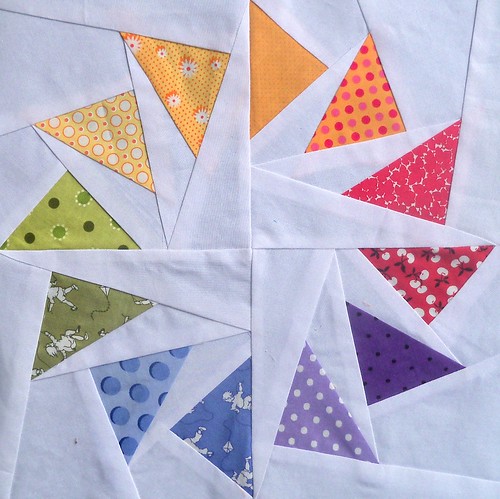Putting the Sampler Quilt Together - Part One
I am hoping this series of posts on turning the stack of We Can Do It! Skill Builder Sampler blocks into a quilt will be a resource not just for those who have made the sampler blocks, but others who are looking for more info on making and finishing quilts.
So let's get started! You have finished all of the blocks in the sampler. Now what?
Take a Walk Down Memory Lane
(or Assess and Repair the Damage) :)
Outcome 1:
So let's get started! You have finished all of the blocks in the sampler. Now what?
Take a Walk Down Memory Lane
(or Assess and Repair the Damage) :)
- The first step is to gather all of the blocks and give them a good press and starch. Goodness knows they deserve a bit of TLC after being stored for a year. :)
- As you press look for stray threads on the back of the blocks and trim them off.
- If any parts of the block stick out 1/4 of an inch or more from the main block trim them even or at least within 1/8 of an inch of the main block.
- Measure the blocks. All of the Skill Builder Sampler blocks should measure 12.5 inches. Sort the blocks. Put all of the 12.5 inch blocks in one pile. The 12.5-12.25 inch blocks in another. The 12.25-12 inch blocks in another and so on.
- Count up the blocks in each pile. There are a couple of different outcomes that may affect how you put together your sampler
Outcome 1:
All of your blocks are exactly 12.5 inches. Great Job! There should be no problems putting together your sampler.
Outcome 2:
All of the blocks are 12.25 inches or larger. Putting the sampler together should still be fairly simple. We can ease and work around a 1/4 inch shortage.
Outcome 3:
Most of the blocks are 12.25 inches or larger but a few are smaller. It is possible in this case to bring the few smaller blocks up to size. (This was my outcome. See below for how to bring the blocks up to size.)
Outcome 4:
Half of the blocks are one size and half are another. You may want to consider making two quilts - one with each size of block.
Outcome 5:
The blocks are of various sizes and you want to put them together in one quilt. You can make a 'border type' sashing to bring all of the blocks up to the same size. Vanessa's quilt is an example of this.
Bringing a Few Undersized Blocks Up to Size
The easiest way to bring some of your smaller blocks up to size is to trim the block down down and add a border.
This is fairly straight forward when dealing with blocks that have no edge points such as this Flowering Snowball block. Mine is 12 inches square and would be impossible to work in with the other 12.5 inch blocks as is. However, I can easily trim it down to 10 inches without loosing the overall pattern.
So, with blocks that will not be harmed by trimming, trim the block down to 10 inches square. Add 2 inch strips to each side and then the top and bottom. Trim to 12.5 inches square.
It is still possible to work with the pattern of the block. I could trim it down quite a bit as shown above and add a border, or I could add a narrow border on just two sides to bring it up to size. Thankfully, this was the only block that had a design that did not lend itself to serious trimming.
If you have a lot of these types of blocks that are under 12.25 inches I would consider either making two quilts with different sized blocks in each, or putting borders on all of the blocks and bringing them up to a standard size (14-16 inches perhaps) as seen in Vanessa's quilt.
Next week we will talk about layout and sashing options.
Bringing a Few Undersized Blocks Up to Size
The easiest way to bring some of your smaller blocks up to size is to trim the block down down and add a border.
This is fairly straight forward when dealing with blocks that have no edge points such as this Flowering Snowball block. Mine is 12 inches square and would be impossible to work in with the other 12.5 inch blocks as is. However, I can easily trim it down to 10 inches without loosing the overall pattern.
So, with blocks that will not be harmed by trimming, trim the block down to 10 inches square. Add 2 inch strips to each side and then the top and bottom. Trim to 12.5 inches square.
This Minnesota block is a different story. It is just under 12 inches and if I trimmed it down to 10 inches the points would be cut off and it would look silly.
It is still possible to work with the pattern of the block. I could trim it down quite a bit as shown above and add a border, or I could add a narrow border on just two sides to bring it up to size. Thankfully, this was the only block that had a design that did not lend itself to serious trimming.
If you have a lot of these types of blocks that are under 12.25 inches I would consider either making two quilts with different sized blocks in each, or putting borders on all of the blocks and bringing them up to a standard size (14-16 inches perhaps) as seen in Vanessa's quilt.
Next week we will talk about layout and sashing options.








